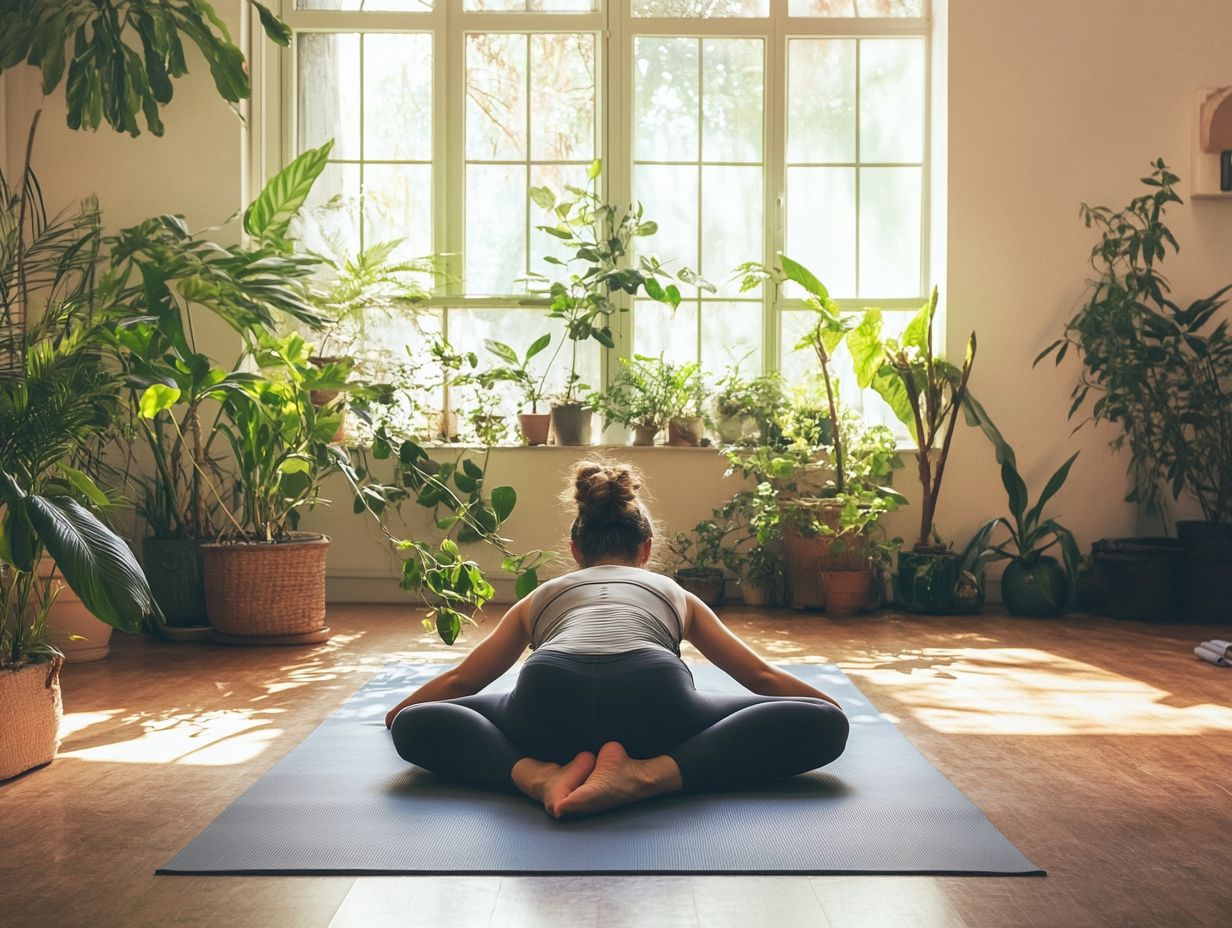How to Strengthen Your Spine Through Yoga
A healthy spine is essential for overall well-being, supporting everything from posture to mobility.
Yoga can be a powerful tool in strengthening your spine and enhancing spine health. By understanding the key movements and essential poses, you can create a sustainable yoga routine tailored to your needs.
Incorporating these practices into your daily life can unlock the potential for a stronger, more resilient spine.
Understanding the Importance of Spine Health

The spine is an essential structure that provides support to the body, aids in maintaining posture, and facilitates movement; thus, understanding its health is imperative for overall wellness and daily functioning.
This remarkable column of vertebrae not only safeguards the spinal cord but also plays a critical role in maintaining proper alignment, which is vital for achieving optimal physical performance. When the spine is appropriately aligned, it reduces the risk of developing back pain, a prevalent condition that can considerably impede daily activities.
Spinal health is intricately connected to both physical and mental well-being. A strong and flexible spine enhances mobility, enabling a more active lifestyle. This increased activity can, in turn, improve mood and reduce stress levels, underscoring the significance of incorporating exercises that promote spinal integrity and balance into one’s daily routine.
The Role of Yoga in Strengthening Your Spine
Yoga is a highly effective method for strengthening the spine by promoting flexibility and enhancing awareness of the body’s natural alignment through various poses and movements.
Practices such as Downward Dog, Cobra, and Child’s Pose can lead to significant improvements in spinal health. These poses facilitate the elongation of the vertebrae while emphasizing the importance of maintaining a neutral spine. Proper alignment in each pose not only mitigates the risk of injury but also maximizes the benefits of the stretches, enabling the body to achieve its full potential.
The mindfulness component of yoga further enhances body awareness, allowing practitioners to become attuned to their physical sensations, which aids in the effective management of tension and stress. By cultivating this connection, yoga serves as a holistic approach to spinal care, integrating physical practice with mental clarity to promote overall wellness.
Key Movements of the Spine
A comprehensive understanding of the key movements of the spine—namely flexion, extension, rotation, side bend, and axial extension—is essential for maintaining spinal health and achieving a strong, flexible back through the practice of yoga.
Flexion
Flexion of the spine refers to the act of bending forward, which facilitates increased mobility and flexibility, essential for maintaining a healthy spine.
This natural movement not only enhances physical well-being but also plays a vital role in daily activities, such as reaching for objects or tying shoelaces. A comprehensive understanding of the anatomical aspects of spinal flexion can significantly improve one’s approach to fitness and health.
When practiced with mindfulness, spinal flexion offers numerous benefits, including improved posture, reduced back pain, and enhanced muscle tone.
In the context of yoga, various poses exemplify this movement, such as Paschimottanasana (Seated Forward Bend) and Uttanasana (Standing Forward Bend). These poses encourage deep stretching of the back and hamstrings while promoting a sense of calm.
Incorporating these poses into a regular routine can greatly contribute to improved mobility and overall wellness.
Extension

Spinal extension refers to the movement that involves bending the back backward, which enhances strength and alignment while promoting flexibility and balance within the spine.
This fundamental motion is crucial for maintaining overall spinal health, as it helps to counteract the detrimental effects of prolonged sitting and poor posture. By lengthening and expanding the spinal column, individuals can relieve tension and stiffness in the back, thereby reducing the risk of injury.
In yoga practices, spinal extension is commonly incorporated through various poses, including:
- Cobra Pose (Bhujangasana)
- Upward-Facing Dog (Urdhva Mukha Svanasana)
- Bridge Pose (Setu Bandhasana)
These asanas not only facilitate spinal extension but also engage the core muscles, thus fostering stability and strength, which are essential for promoting a balanced body and mind.
Rotation
The rotation of the spine facilitates a range of motion that is essential for functional movement and overall spinal health, contributing to flexibility and relief from tension.
This fundamental movement plays a crucial role in daily activities, such as twisting to reach objects and turning the head to observe the surroundings, thereby underscoring its importance in promoting an active lifestyle.
Engaging in yoga is an effective method for enhancing spinal rotation while also fostering core strength and stability. Specific poses, such as the Revolved Chair (Parivrtta Utkatasana) and Half Lord of the Fishes (Ardha Matsyendrasana), promote the natural twisting of the spine, enabling practitioners to develop a heightened awareness of their bodies and improve their overall mobility.
By prioritizing spinal rotation through these mindful practices, individuals can achieve improved physical well-being and cultivate a deeper connection to their body’s capabilities.
Side Bend
Side bending is an essential movement for the spine that enhances lateral flexibility and balance, both of which are critical for maintaining spinal health.
Incorporating side bending into daily routines, particularly through yoga practices, can significantly enhance overall well-being. These movements help alleviate tension in the back and promote improved posture, which is particularly important for individuals who spend long hours seated.
Engaging in side bends stimulates the intercostal muscles and enhances breathing capacity, ultimately benefiting cardiovascular health. Prominent yoga poses such as Extended Side Angle and Triangle Pose demonstrate the efficacy of these movements.
By embracing these poses, individuals not only enhance their flexibility but also develop a deeper understanding of their body’s alignment, thereby reinforcing the importance of maintaining a healthy spine.
Axial Extension
Axial extension is a fundamental movement that facilitates the elongation of the spine, significantly contributing to improved posture and spinal alignment.
This essential component of spinal health not only enhances the overall functionality of the body but also alleviates discomfort related to tightness and misalignment. Engaging in practices that promote axial extension enables individuals to develop a strong connection between the body and mind, which is beneficial for injury prevention and enhances athletic performance.
In yoga, several postures effectively support axial extension, including Mountain Pose (Tadasana) and Cobra Pose (Bhujangasana). By performing these asanas, practitioners create space between the vertebrae and engage the core muscles, thereby fostering a healthy spine while promoting a sense of grounding and balance throughout the body.
Essential Yoga Poses for a Stronger Spine

Incorporating fundamental yoga poses into a daily practice can substantially strengthen the spine, enhance flexibility, and improve overall health and well-being.
1. Cat-Cow Pose (Marjaryasana-Bitilasana)
The Cat-Cow Pose (Marjaryasana-Bitilasana) is a dynamic movement that enhances spinal flexibility and alleviates tension in the back. This gentle flow between two positions serves as an effective method to warm up the spine prior to engaging in more vigorous yoga practices.
To perform this pose, one should begin on all fours, ensuring that the wrist are positioned directly under the shoulders and the knees are aligned under the hips. As one inhales, the back should be arched while lifting the head and tailbone towards the ceiling, thereby creating a gentle upward curve. Conversely, upon exhaling, the back should be rounded, with the chin tucked toward the chest and the belly button drawn toward the spine. This rhythmic motion not only promotes spinal health but also facilitates improved circulation and relaxation.
Maintaining proper alignment is crucial; it is important to keep the neck in a neutral position and to avoid excessive arching of the lower back. Concentrating on controlled, deep breaths throughout this sequence can significantly enhance both the benefits and the overall experience of the practice.
2. Cobra Pose (Bhujangasana)
Cobra Pose (Bhujangasana) is a fundamental yoga posture that strengthens the spine, enhances back flexibility, and promotes proper posture. This foundational pose serves as a cornerstone in many yoga routines, making it accessible to practitioners of all levels.
To perform Cobra Pose effectively, one should begin by lying face down on the mat with the legs extended and feet positioned hip-width apart. The palms should be placed flat on the ground beneath the shoulders, keeping the elbows close to the body.
For more tips on how to strengthen your spine through yoga, check out this helpful resource.
As one inhales, it is important to gently lift the chest off the ground while engaging the back muscles, ensuring that the lower body remains relaxed and grounded. This movement not only elongates the spine but also opens the chest, facilitating deeper breaths.
Regular practice of Cobra Pose can alleviate tension in the lower back and improve spinal alignment, thereby supporting optimal body function.
3. Bridge Pose (Setu Bandhasana)
Bridge Pose (Setu Bandhasana) is an effective yoga posture that enhances spinal strength and gluteal engagement while promoting flexibility and proper alignment.
This asana not only invigorates the back muscles but also improves overall body awareness and coordination. Practicing Bridge Pose contributes to the opening of the heart and chest, facilitating deeper breathing and alleviating stress and fatigue.
To achieve proper form, one should lie supine, with the knees bent and feet flat on the ground at hip-width apart. By pressing into the feet and engaging the core, the individual can elevate the hips while ensuring proper alignment of the shoulders and knees.
Maintaining the pose for several breaths can significantly cultivate spinal strength, making it a valuable addition to any comprehensive yoga practice.
4. Locust Pose (Salabhasana)

Locust Pose (Salabhasana) is a dynamic asana that effectively targets the entire spine, fostering strength, flexibility, and improved posture.
This vigorous position encourages practitioners to engage their back muscles thoroughly, contributing to enhanced alignment and mitigating the risk of back-related injuries.
To perform Locust Pose, one should commence by lying flat on their stomach, with arms resting alongside the body and palms facing upward. Upon inhalation, the individual should lift the legs, chest, and arms off the ground while maintaining a forward gaze, thereby creating a gentle arch in the back that enhances spinal resilience.
Sustaining this posture not only strengthens the lower back but also opens the chest, thereby improving lung capacity and breathing control. The benefits of this pose extend beyond physical strength, contributing to overall well-being and making it an essential component of any comprehensive yoga practice.
5. Warrior I Pose (Virabhadrasana I)
Warrior I Pose (Virabhadrasana I) not only enhances spinal strength but also promotes a sense of stability and balance, which are essential for overall health. This foundational yoga asana is intended to align the spine, improve posture, and build endurance in the lower body.
To practice Warrior I Pose effectively, practitioners should begin in a standing position and step one foot back while bending the front knee and keeping the back leg straight. It is crucial to square the hips toward the front of the mat to ensure proper spinal alignment.
The arms should be extended overhead, with fingers reaching toward the sky, which aids in creating a sense of grounding and expansion. Regular practice of this pose can lead to increased strength in the legs and core, as well as enhanced flexibility in the hips.
To maintain proper form, it is important to engage the core, keep the shoulders relaxed, and breathe deeply, ensuring that the neck remains aligned with the spine. By adhering to these principles, individuals can fully experience the benefits of this powerful pose.
6. Seated Forward Bend (Paschimottanasana)
Seated Forward Bend (Paschimottanasana) is a restorative pose that enhances spinal flexibility and relaxation while providing a gentle stretch to the entire back.
Regular practice of this pose can markedly improve overall spinal health by promoting proper alignment and alleviating tension in the lower back. To begin, sit on the floor with the legs extended straight in front, ensuring the spine remains erect. Inhale deeply, and as you exhale, hinge at the hips to fold forward, reaching towards the feet. It is crucial to maintain an elongated spine, avoiding any rounding of the back.
Once in position, holding the pose for several breaths allows for a deeper stretch and fosters mindfulness. The benefits of Seated Forward Bend extend beyond flexibility; this pose also offers significant stress relief and enhances circulation.
Yoga Practices to Incorporate Daily
Incorporating specific yoga practices into a daily routine can significantly enhance spinal health, improve flexibility, and cultivate mindfulness and awareness.
By integrating gentle stretches and targeted poses, individuals may experience considerable relief from tension and discomfort that often arise from prolonged sitting or poor posture. Simple practices such as Cat-Cow, Child’s Pose, and Downward Dog not only promote spinal alignment but also encourage deep breathing, which can reduce stress levels and enhance overall wellness.
Devoting just a few minutes each day to these mindful movements can foster a deeper connection between the mind and body, resulting in improved mental clarity and emotional stability. Furthermore, consistent yoga practice nurtures a sense of community and can inspire others to prioritize their health.
Benefits of Regular Yoga for Spine Health
Consistent yoga practice provides a variety of advantages for spinal health, including increased flexibility, enhanced strength, and a reduction in tension within the back muscles.
